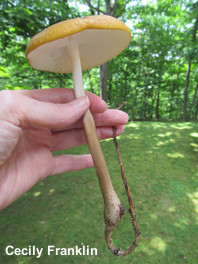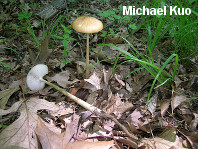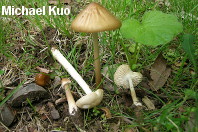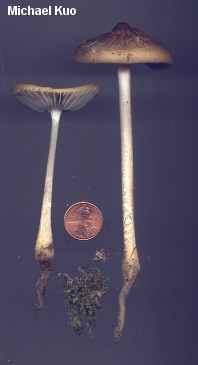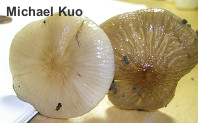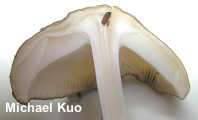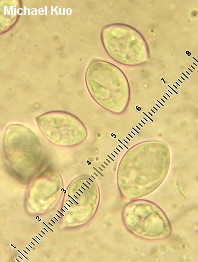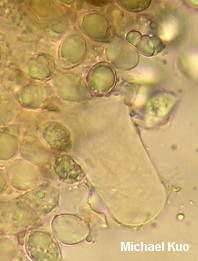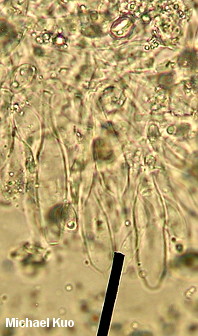| Major Groups > Gilled Mushrooms > Pale-Spored > Collybioid> > Xeruloid > Hymenopellis incognita |

|
Hymenopellis incognita [ Basidiomycota > Agaricales > Physalacriaceae > Hymenopellis . . . ] by Michael Kuo Hymenopellis incognita is a xeruloid mushroom that was included in the broad concept of "Oudemansiella radicata" until a few decades ago, when researchers began to break that concept up into more narrowly defined species. Hymenopellis incognita was originally described as an eastern North American "biological species," supported by mating studies (Petersen & Methven, 1994)—and a later DNA study (Petersen & Hughes, 2010) supported the species with phylogenetic evidence. It is very similar in appearance to Hymenopellis furfuracea, Hymenopellis megalospora, and to the European species Hymenopellis radicata—but it can be separated from these look-alikes with microscopic analysis (see the Key to 9 xeruloid mushrooms in North America and the information below for details). Although Hymenopellis incognita has been documented from a relatively small geographic area (from Missouri to North Carolina and Pennsylvania), it may be more widely distributed, disguised in the records as other, similar species. Older field guides often combined Hymenopellis incognita with what have since been designated as separate species of Hymenopellis, in treatments of "Collybia radicata," "Oudemansiella radicata," and "Xerula radicata." Thanks to Cecily Franklin for collecting, documenting, and preserving Hymenopellis incognita for study; her collection is deposited in The Herbarium of Michael Kuo. Description: Ecology: Saprobic on the deadwood of hardwoods (especially hickories); occasionally growing directly from very well decayed logs and stumps, but more commonly attached to buried deadwood near stumps, appearing terrestrial; late spring through fall; originally described from Coles County, Illinois, and since documented in Missouri, North Carolina, Pennsylvania, and Tennessee—perhaps to be expected throughout eastern North America. The illustrated and described collections are from Pennsylvania and Illinois (including Coles County, the county of the holotype collection). Cap: 2–10 cm across; bell-shaped to sub-conic when young, becoming broadly bell-shaped, broadly convex, or nearly flat in age; bald; usually somewhat radially wrinkled in a zone around the center; slimy to sticky or greasy when fresh, but soon dry; color variable—ranging from ivory to brownish yellow to yellow-brown or brown when young, becoming whitish or grayish brown with a darker center. Gills: Attached to the stem by means of a notch; distant or nearly so (occasionally close); white; thick; short-gills frequent. Stem: 6–17 cm long above ground; 4–15 mm thick; tapering to apex; bald or very finely silky/hairy; whitish to pale brownish; with a long, tapered tap root extending 4–18 cm underground; tap root sometimes staining yellowish brown to reddish brown. Flesh: White; thin; unchanging when sliced. Odor and Taste: Not distinctive. Chemical Reactions: KOH on cap surface negative. Dried Specimens: Gills of dried specimens become yellowish to very pale orangish after several years in storage. Spore Print: White. Microscopic Features: Spores 12–19 x 9–13 µm; sublimoniform to subamygdaliform; smooth; hyaline in KOH; inamyloid. Hymenial elements hyaline to dull brown in KOH. Pleurocystidia widely cylindric to very broadly fusiform or subutriform; 75–140 x 20–30 µm; hyaline to ochraceous or brownish in KOH; smooth; thin-walled. Cheilocystidia fusiform to cylindric; up to 125 x 30 µm. Pileipellis hymeniform and somewhat gelatinized; pileocystidia scattered (sometimes very rare), thin-walled, hyaline, up to 80 x 20 µm. REFERENCES: (Methven & Petersen, 1994) R. H. Petersen, 2010. (Methven & Petersen, 1994; Petersen & Hughes, 2010.) Herb. Kuo 06170202, 05120705, 05170705, 05170706, 05240802, 05241102, 05101603, 07011601. This website contains no information about the edibility or toxicity of mushrooms. |
© MushroomExpert.Com |
|
Cite this page as: Kuo, M. (2016, August). Hymenopellis incognita. Retrieved from the MushroomExpert.Com Web site: http://www.mushroomexpert.com/hymenopellis_incognita.html |
